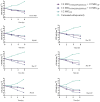Enhanced therapeutic efficacy of silibinin loaded silica coated magnetic nanocomposites against Pseudomonas aeruginosa in Combination with Ciprofloxacin and HepG2 cancer cells
- PMID: 40596538
- PMCID: PMC12217157
- DOI: 10.1038/s41598-025-07529-x
Enhanced therapeutic efficacy of silibinin loaded silica coated magnetic nanocomposites against Pseudomonas aeruginosa in Combination with Ciprofloxacin and HepG2 cancer cells
Abstract
Silibinin, a major bioactive compound extracted from Silybum marianum, possesses notable antioxidant, antitumor, hepatoprotective, and antibacterial activities. However, its poor solubility limits its clinical applications. This study aimed to enhance the delivery of silibinin by synthesizing magnetic nanocomposites (MNCs) and evaluating their efficacy against clinical isolates of Pseudomonas aeruginosa and HepG2 cancer cells. The physicochemical properties of the Fe3O4@SiPr@Silibinin nanocomposites were characterized by FT-IR, TGA-DTG, TEM, FE-SEM, XRD, and VSM analysis. Clinical isolates and a standard strain of P. aeruginosa were treated with Fe3O4@SiPr@Silibinin (at sub-MIC level) in combination with ciprofloxacin (sub-MIC), and the results were compared to treatment with ciprofloxacin alone. Additionally, the anticancer effects of Fe3O4@SiPr@Silibinin were evaluated in HepG2 cells. The nanocomposites, with particle sizes ranging from 40 to 80 nm, significantly enhanced the antimicrobial activity of ciprofloxacin when used in combination. Treatment with Fe3O4@SiPr@Silibinin plus ciprofloxacin led to a downregulation of biofilm and efflux pump-related gene expression compared to ciprofloxacin treatment alone. Furthermore, Fe3O4@SiPr@Silibinin exhibited anti-cancer activity against HepG2 cells, with an IC₅₀ value of 35.79 µg/mL In Silibinin-treated HepG2 cells, upregulation of the P53 gene and downregulation of the Bcl2 gene were observed. Our findingssuggest that Fe3O4@SiPr@Silibinin MNCs, with high stability and water solublity, can efficiently deliver silibinin into pathogenic and tumorigenic cells, thereby enhancing its therapeutic effects against P. aeruginosa and HepG2 cells. Given the antimicrobial and antitumor properties of silibinin, these magnetic nanocarriers represent a promising strategy for its targeted delivery.
Keywords: Pseudomonas aeruginosa; Apoptosis; Fe3O4@SiPr; HepG2 cells; Silibinin.
© 2025. The Author(s).
Conflict of interest statement
Declarations. Competing interests: The authors declare no competing interests. Ethical approval: This study was conducted in full accordance with the guidelines and recommendations of the ethics committee. The study protocol was reviewed and approved by the Ethics Committee of Human Experiments at the Rasht Branch of Islamic Azad University, Rasht, Iran (Approval Code: IR.IAU.RASHT.REC.1401.040).
Figures








References
-
- Takke, A. & Shende, P. Magnetic-core-based Silibinin nanopolymeric carriers for the treatment of renal cell cancer. Life Sci.275, 119377 (2021). - PubMed
-
- Wu, J. et al. Silybin: A review of its targeted and novel agents for treating liver diseases based on pathogenesis. Phytother. Res.38 (12), 5713–5740 (2024). - PubMed
-
- XIE, S. L. Antibacterial spectrum of Silibinin and isomers and its antibacterial effect with antibiotics. Chin. Tradit. Herb. Drugs: pp. 1641–1648. (2019).
MeSH terms
Substances
LinkOut - more resources
Full Text Sources
Medical
Research Materials
Miscellaneous

